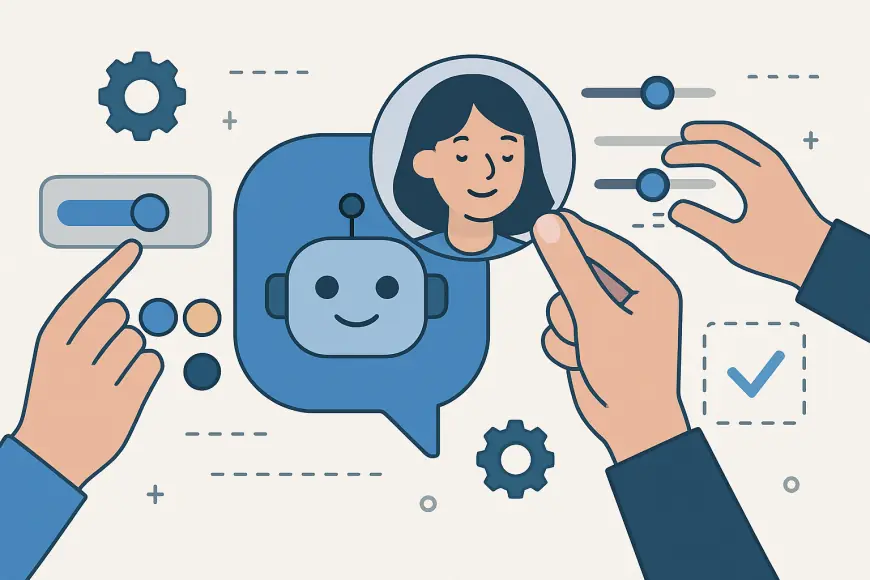How to Build AI Chatbot Using Python: Frameworks, Libraries, and Examples
-
How to Build AI Chatbot Using Python: Frameworks, Libraries, and Examples

How to Build AI Chatbot Using Python: Frameworks, Libraries, and Examples
Artificial Intelligence is transforming digital interaction across industries. From customer support to sales automation, chatbots have become one of the most widely adopted tools in modern AI development. Among the many programming languages available, Python has emerged as the top choice for chatbot creation because of its simplicity, versatility, and extensive libraries. If you are a beginner or a business owner curious about how to build AI chatbot, this article explores the process of building chatbots using Python, highlighting frameworks, libraries, and practical examples.
As we move into 2025, the importance of AI Chatbot Development has only increased. Enterprises, startups, and SMEs are all investing in chatbots to enhance customer engagement, automate workflows, and scale operations. Python makes this process accessible while providing the flexibility required for both small-scale prototypes and large enterprise-level chatbot solutions.
Why Choose Python for AI Chatbot Development?
When discussing AI chatbot development, Python stands out because of its readability, extensive community support, and powerful libraries for natural language processing and machine learning. Unlike other programming languages, Python allows developers to build AI models quickly, test prototypes, and integrate them with different platforms efficiently.
For businesses looking at AI Chatbot Development services, Python ensures that the chatbot is not only functional but also scalable. It can be integrated with web applications, mobile applications, or even enterprise platforms, making it highly adaptable. This level of flexibility is vital in industries where customer needs and business goals are constantly evolving.
Understanding the Basics Before You Start
To understand how to build AI chatbot, it is important to know what separates an intelligent chatbot from a rule-based one. Rule-based bots follow predefined commands and scripts. On the other hand, AI-powered bots rely on machine learning and NLP to understand user intent and provide meaningful responses. Python enables the development of both but is most powerful when used for intelligent conversational models.
For instance, a rule-based bot might respond to “What is your business hour?” with a fixed reply. An AI chatbot built with Python, however, can understand variations of the same question like “When are you open?” or “Can I visit on weekends?” by using NLP libraries. This capability is the backbone of modern AI chatbot development.
Popular Frameworks for AI Chatbot Development in Python
Frameworks are essential in simplifying chatbot creation. Python offers several robust frameworks that reduce the amount of repetitive coding required. One of the most widely used is Rasa, an open-source conversational AI framework that combines NLP and dialogue management. Rasa enables businesses to build scalable and secure chatbots without vendor lock-in.
Another popular option is Microsoft Bot Framework, which also supports Python integrations. This framework is especially useful for enterprises seeking AI Chatbot Development services that require omnichannel support across platforms like Teams, Slack, and Facebook Messenger.
Flask and Django are also commonly used in web development to integrate chatbots into websites. These frameworks allow chatbots to become an integral part of web applications, providing real-time customer interaction. In addition, companies working on app development often use these frameworks in combination with mobile-friendly APIs to ensure chatbot accessibility across devices.
Libraries That Power Python Chatbots
Python’s strength lies in its libraries. Natural Language Toolkit (NLTK) and spaCy are two of the most powerful NLP libraries available. They help the chatbot process and understand human language more effectively. With NLTK, developers can train models to recognize parts of speech, sentiment, and named entities, while spaCy provides faster performance for production-ready chatbots.
For deep learning capabilities, TensorFlow and PyTorch are essential. These libraries allow developers to design neural networks that enhance chatbot intelligence. With these, businesses can go beyond basic AI chatbot development and build systems capable of handling complex, multi-turn conversations.
Additionally, ChatterBot is a Python library designed specifically for building chatbots. It uses machine learning algorithms to generate responses based on the dataset provided. While it may not be as advanced as custom NLP pipelines, it provides beginners an easy entry point into how to build AI chatbot with Python.
Step 1: Defining Use Cases
Before diving into coding, the first step in chatbot creation is defining the use case. Do you want your chatbot to handle customer support, act as a virtual shopping assistant, or provide healthcare guidance? Each use case demands different conversational flows and integrations.
Businesses seeking AI Chatbot Development services often start by outlining clear objectives. For example, an e-commerce brand may want a chatbot that recommends products, while a healthcare provider may need a chatbot that schedules appointments and provides medical reminders. Python makes it easy to adapt the codebase to different use cases, whether simple or complex.
Step 2: Setting Up Python Environment
The next step in how to build AI chatbot with Python is setting up the environment. Python provides multiple environments through Anaconda or virtualenv where developers can install dependencies like TensorFlow, spaCy, or Flask. This setup phase is essential because it ensures smooth execution of libraries during development.
Once the environment is ready, developers usually create a basic chatbot structure with Python scripts. From there, they can build on the logic, integrate NLP modules, and design conversation flows. This phase is where the foundation of AI chatbot development is laid.
Step 3: Training Chatbots with NLP
Training is where Python’s power shines. By using datasets, you can train the chatbot to understand customer queries. For instance, if building a banking chatbot, you might feed it thousands of examples of queries about balances, loans, and payments. NLP libraries then process this data and build a model capable of interpreting real-world inputs.
This stage is not only about creating accurate responses but also about handling ambiguity. For example, if a user types “I need help with my account,” the chatbot must be able to ask clarifying questions. This adaptability makes Python ideal for professional AI Chatbot Development services, where accuracy and customer satisfaction are critical.
Step 4: Designing Conversational Flow
Conversation design is the art of making interactions feel natural. Using Python frameworks, developers create dialogue management systems that ensure smooth communication. For example, if a user asks about product availability, the chatbot must first confirm which product the user is referring to, then check the database, and finally provide a response.
This process requires combining AI chatbot development with custom software development expertise, especially when integrating chatbots into enterprise systems. Businesses can also expand chatbot functionality with AI agent development, where chatbots are capable of performing actions like booking services, processing transactions, or updating customer profiles.
Step 5: Integrating with Business Platforms
No chatbot is complete without integration. Chatbots must connect with CRMs, payment gateways, inventory systems, or patient databases depending on the use case. Python APIs make this integration process smooth. For instance, a Django-based chatbot can connect to a PostgreSQL database to retrieve customer information in real time.
Companies offering AI Chatbot Development services prioritize this phase, as seamless integration ensures that chatbots deliver meaningful business value. Whether it is through web development for websites or app development for mobile platforms, Python chatbots can be deployed across multiple touchpoints.
Step 6: Testing and Deployment
Testing ensures that the chatbot performs as expected under real-world conditions. With Python, developers can simulate conversations, analyze accuracy, and refine models before deployment. Testing is crucial in AI chatbot development because even small errors can frustrate customers.
Deployment depends on the platform. Chatbots can be deployed on cloud services like AWS, Azure, or Google Cloud. They can also be embedded directly into websites or mobile apps. The flexibility of Python ensures that chatbots can scale with business needs, making them suitable for both startups and large enterprises.
Real-World Examples of Python-Based Chatbots
In the retail sector, Python chatbots are widely used to recommend products, answer FAQs, and assist customers with purchase decisions. Healthcare organizations use Python chatbots to handle appointment scheduling, provide medication reminders, and deliver health advice. Educational institutions deploy them as virtual tutors that answer student queries and provide learning resources.
These examples highlight the adaptability of Python in AI chatbot development. By leveraging AI Chatbot Development services, businesses can create industry-specific chatbots tailored to their goals.
Challenges in Building Chatbots with Python
While Python makes chatbot creation easier, challenges remain. Training models requires large datasets, and ensuring accuracy can be difficult in industries with complex jargon like healthcare or finance. Integration with legacy systems can also be a hurdle.
Businesses that lack in-house expertise often turn to professional AI Chatbot Development services to overcome these challenges. By combining AI development, custom software development, web development, and app development, these services ensure chatbots are functional, secure, and scalable.
Future of Python in AI Chatbot Development
The future of chatbots is moving beyond simple conversations to advanced AI agents. With AI agent development, chatbots will not only answer queries but also perform tasks autonomously, such as booking appointments, managing workflows, or even making decisions based on data. Python will continue to play a central role in this transformation due to its adaptability and rich ecosystem of libraries.
In 2025 and beyond, businesses that invest in Python-based chatbots will benefit from faster development cycles, improved customer experiences, and reduced operational costs. As chatbot adoption grows across industries, Python will remain the backbone of AI chatbot development worldwide.
Conclusion
Learning how to build AI chatbot using Python is a valuable skill in today’s digital-first economy. With its extensive frameworks, powerful libraries, and ease of integration, Python allows developers and businesses to create chatbots that are intelligent, scalable, and industry-ready. From training chatbots with NLP to deploying them across multiple platforms, Python makes the process seamless and efficient.
The rise of AI Chatbot Development and AI Chatbot Development services highlights the growing importance of conversational AI in modern business strategies. Combined with AI development, app development, web development, custom software development, AI chatbot development, and AI agent development, Python-based chatbots empower businesses to stay competitive, engage customers effectively, and drive innovation.
For beginners and enterprises alike, mastering Python in chatbot creation is the first step toward unlocking the full potential of conversational AI.
What's Your Reaction?
 Like
0
Like
0
 Dislike
0
Dislike
0
 Love
0
Love
0
 Funny
0
Funny
0
 Angry
0
Angry
0
 Sad
0
Sad
0
 Wow
0
Wow
0



















































